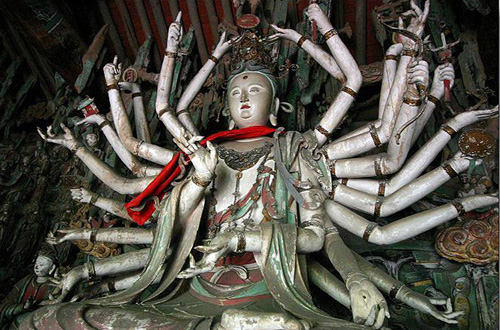 |
|
A thousand-armed Bodhisattva sculpture pictured in Shuanglin Temple, Pingyao county. The temple has a history dating backing more than 1,400 years and is an important part of the Ancient City of Pingyao, a 2,700-year-old UNESCO World Heritage Site. [Photo/China Daily] |
The first international sculpture festival is currently taking place in the Ancient City of Pingyao, a 2,700-year-old UNESCO World Heritage Site, from July 20 to Aug 20.
There is a profound historical relationship between Pingyao and sculpture art because of Shuanglin Temple which is known for its beautiful and unique painted sculptures, according to Wu Xiaohua, a top government official of Pingyao.
Located around 6 kilometers from the ancient city center, Shuanglin Temple as a part of the renowned World Heritage Site, has a history dating backing more than 1,400 years, and is famous for its colored clay sculptures.
The temple's 10 halls, which were mostly restored in the Yuan (1271-1368) and Ming (1368-1644) dynasties, have more than 2,000 sculptures (out of which 1,650 are reported to be extant) from 11 dynasties, ranging from the Song (960-1279) to the Qing (1644-1911) dynasties.
The colored clay statues are treasures of the ancient arts. It was uncommon for domestic temples to have secular images. The themes depicted are generally religious in nature and relate to everyday life.
The different types of sculpture are bas-relief (carved deep into a surface to give them the impression of protruding from a background), high relief (protruding far out from a background) and in circular form. There are also wall sculptures and a few are suspended. The background scenes depict towers, buildings, mountains, rivers, clouds, rocks, grass, flowers and woodlands.
All the sculptures in Shuanglin Temple retain their bright colors despite their long history, showcasing the quintessence of traditional Chinese sculpture art.
Pingyao's existence and historical value can be communicated through international cultural exchanges, especially through sculpture art, said Wu Weishan, general curator of Pingyao international sculpture festival.
"Sculpture projects at Ping Yao are totally unlike the city’s other two art festival brands – Pingyao International Photography Festival and Pingyao International Film Festival which did not evolve from cultural elements of Pingyao. Pingyao is the most qualified to be capital of sculpture in China based on its deep sculpture art roots," said Shi Yong, a top government official of the city.
"Under the premise of protecting and promoting history and culture, we hope to build such a platform for a dialogue between Pingyao and the art world to develop sculpture art, with an inclusive and open attitude, not only to explore traditional Pingyao sculpture culture, but also to accept modern Western interpretations of the art," he said, explaining why the city had decided to hold the sculpture festival.